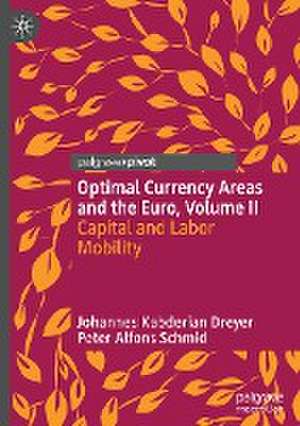Optimal Currency Areas and the Euro, Volume II: Capital and Labor Mobility
Autor Johannes Kabderian Dreyer, Peter Alfons Schmiden Limba Engleză Hardback – 24 aug 2023
Preț: 317.68 lei
Nou
Puncte Express: 477
Preț estimativ în valută:
60.79€ • 66.24$ • 51.22£
60.79€ • 66.24$ • 51.22£
Carte tipărită la comandă
Livrare economică 23 aprilie-07 mai
Preluare comenzi: 021 569.72.76
Specificații
ISBN-13: 9783031388668
ISBN-10: 3031388666
Pagini: 123
Ilustrații: XIV, 123 p. 14 illus., 3 illus. in color.
Dimensiuni: 148 x 210 mm
Greutate: 0.32 kg
Ediția:1st ed. 2023
Editura: Springer International Publishing
Colecția Palgrave Pivot
Locul publicării:Cham, Switzerland
ISBN-10: 3031388666
Pagini: 123
Ilustrații: XIV, 123 p. 14 illus., 3 illus. in color.
Dimensiuni: 148 x 210 mm
Greutate: 0.32 kg
Ediția:1st ed. 2023
Editura: Springer International Publishing
Colecția Palgrave Pivot
Locul publicării:Cham, Switzerland
Cuprins
Chapter 1 Introduction.- Chapter 2 Literature and Theory.- Chapter 3. Labor Mobility, the Empirics.- Chapter 4. Capital Mobility, the Empirics.- Chapter 5. Conclusion.
Notă biografică
Johannes Kabderian Dreyer is an associate professor of Financial Economics at Roskilde University. He holds a doctorate in Financial Economics from the Ingolstadt School of Management (Catholic University of Eichstätt-Ingolstadt, KU), financed by the German Academic Exchange Service (DAAD).
Peter Alfons Schmid is a professor for business administration, finance and entrepreneurship at the FOM University of Applied Sciences, and contract lecturer at the Free University Bolzano-Bozen. During his doctoral studies, he was teaching and research assistant at the Chair of Economic Theory of the KU, where he earned his doctorate.
Peter Alfons Schmid is a professor for business administration, finance and entrepreneurship at the FOM University of Applied Sciences, and contract lecturer at the Free University Bolzano-Bozen. During his doctoral studies, he was teaching and research assistant at the Chair of Economic Theory of the KU, where he earned his doctorate.
Textul de pe ultima copertă
This book makes a unique contribution to the assessment of Eurozone’s foundations and viability by drawing on factor mobility. It makes essential reading for all professionals keen in Eurozone economics and anyone with a genuine interest on the future of EU/Eurozone. Static and dynamic econometric analysis provide an excellent guide to quants specialists and at the same time navigates the non-specialist through the key issues relating to Eurozone’s capital and labour mobility in a very reader-friendly manner. In this way, readers' ability to evaluate Eurozone’s challenges is greatly enhanced while appreciating the complexities surrounding factor mobility.
—Dimitrios Syrrakos, Head of Economics, Keele Business School, UK.
This book is the second of three volumes that uses the theory of Optimal Currency Areas (OCAs) and applied econometric techniques to provide the reader with a compact analysis of the Euro area, its evolution and future perspectives.Each volume of the series is dedicated to one of the three critical criteria for an OCA: 1) business cycle synchronization, 2) factor mobility and 3) the existence of a risk sharing system. This second volume deals with the criterion of factor mobility. The authors investigate and discuss whether there are signs of labor and capital mobility that have helped dampen economic shocks among the regions of the Euro during its short history. The book is of interest to a wide range of researchers in financial economics, macroeconomics and economic policy.
Johannes Kabderian Dreyer is an associate professor of Financial Economics at Roskilde University. He holds a doctorate in Financial Economics from the Ingolstadt School of Management (Catholic University of Eichstätt-Ingolstadt, KU), financed by the German Academic Exchange Service (DAAD).
Peter Alfons Schmid is a professor for business administration, financeand entrepreneurship at the FOM University of Applied Sciences, and contract lecturer at the Free University Bolzano-Bozen. During his doctoral studies, he was teaching and research assistant at the Chair of Economic Theory of the KU, where he earned his doctorate.
—Dimitrios Syrrakos, Head of Economics, Keele Business School, UK.
This book is the second of three volumes that uses the theory of Optimal Currency Areas (OCAs) and applied econometric techniques to provide the reader with a compact analysis of the Euro area, its evolution and future perspectives.Each volume of the series is dedicated to one of the three critical criteria for an OCA: 1) business cycle synchronization, 2) factor mobility and 3) the existence of a risk sharing system. This second volume deals with the criterion of factor mobility. The authors investigate and discuss whether there are signs of labor and capital mobility that have helped dampen economic shocks among the regions of the Euro during its short history. The book is of interest to a wide range of researchers in financial economics, macroeconomics and economic policy.
Johannes Kabderian Dreyer is an associate professor of Financial Economics at Roskilde University. He holds a doctorate in Financial Economics from the Ingolstadt School of Management (Catholic University of Eichstätt-Ingolstadt, KU), financed by the German Academic Exchange Service (DAAD).
Peter Alfons Schmid is a professor for business administration, financeand entrepreneurship at the FOM University of Applied Sciences, and contract lecturer at the Free University Bolzano-Bozen. During his doctoral studies, he was teaching and research assistant at the Chair of Economic Theory of the KU, where he earned his doctorate.
Caracteristici
Examines typical barriers against migration in the Euro Area Investigates whether the EA has developed a better functioning of this stabilization mechanism since its beginning Draws policy recommendations
